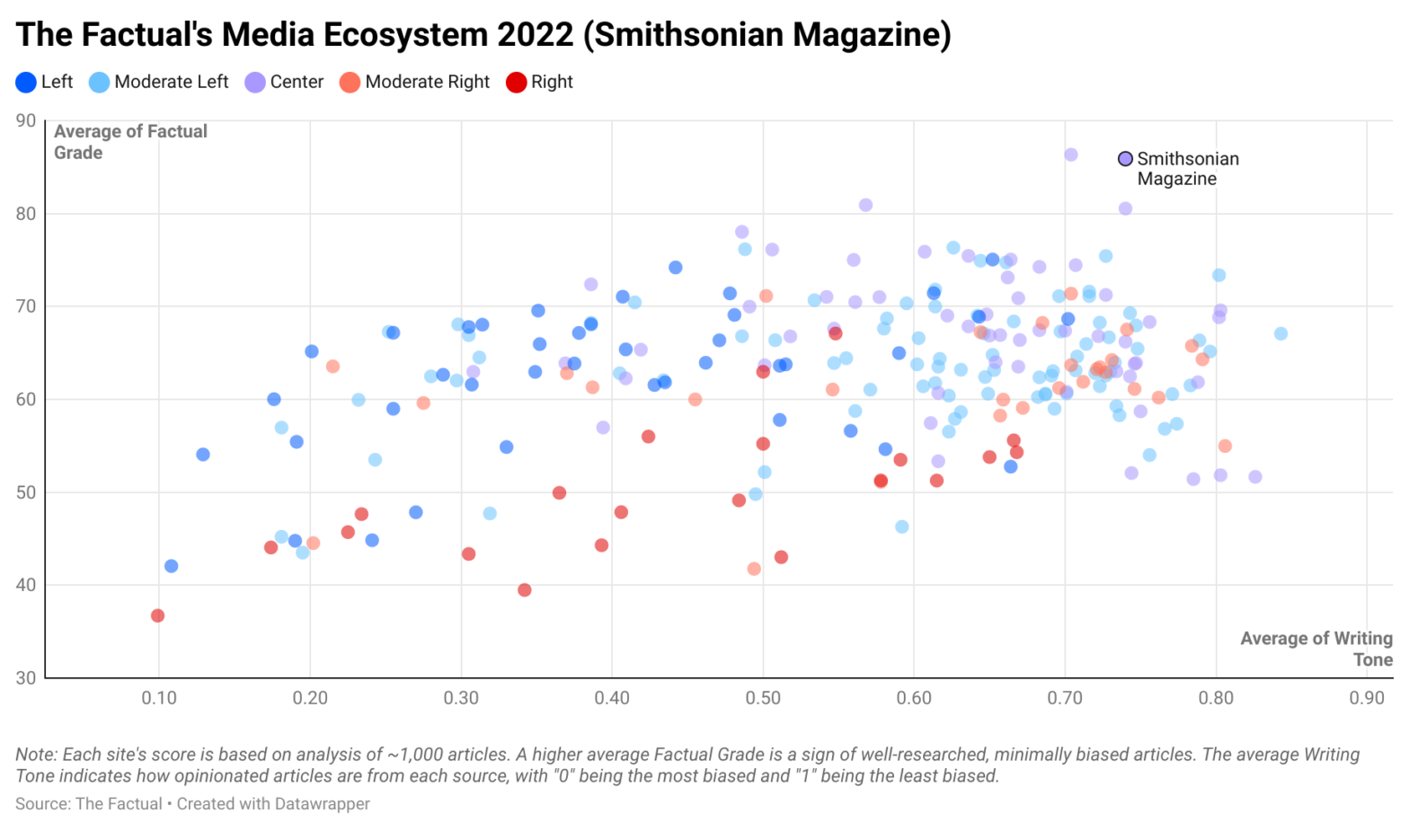Smithsonian Magazine offers a distinct perspective and style of reporting, particularly in the fields of history, nature, popular culture, arts, science, and archeology. Though much of its content is seemingly apolitical, many of its stories actually cover topics that have become deeply political today in America, such as Covid-19 and climate change. So how biased and accurate is Smithsonian Magazine’s reporting?
How Does The Factual Rate News Sources?
The Factual analyzes more than 10,000 news stories every day to help readers find the most informative, least-biased articles. Our news-rating algorithm scores each article along four metrics: (1) cited sources and quotes, (2) publication history, (3) writing tone, and (4) author expertise. These scores combine in a weighted average we call a Factual Grade, which ranges from 0–100%. (See our How It Works page to learn more about our algorithm.)
For this study, we analyzed ~1,000 articles each from 240 news sources. The average Factual Grade for the entire dataset was 62.5%. Based on these averages, we can compare the performance of news sites across the media ecosystem. The entire dataset can be explored in greater detail here.
How Factual Is Smithsonian Magazine?
Smithsonian Magazine scored an average Factual Grade of 85.9%, placing it the 99th percentile of our dataset. In fact, the publication received the second-highest average score in the entire dataset.
A number of factors contribute to Smithsonian Magazine’s high scores. The magazine features dedicated and experienced authors who routinely cover the same topics, leading to high scores for author expertise. Articles tend to incorporate extensive sources and quotes, an indication of thorough research and transparent reporting. Finally, articles from the site tend to be unbiased in their coverage of topics, using balanced language and avoiding sensationalist or click-bait titles.
Like any news source, scores for articles from the Smithsonian Magazine varied widely based on factors like author expertise and cited evidence. For example, many articles score as high as 95% or above, while others score below 60%.
Please check your email for instructions to ensure that the newsletter arrives in your inbox tomorrow.
How Opinionated Is the Smithsonian Magazine?
One of the metrics The Factual uses is the Writing Tone, which measures how opinionated the writing is in an article. For this metric, the algorithm looks for signs of subjective commentary (e.g., first person pronouns and unnecessary adverbs), as well as the emotional nature of selected words, and sees how prevalent they are for a given length of text. More neutral text receives higher ratings, with “0” being the most opinionated and “1” being the most neutral.
The Smithsonian Magazine had an average Writing Tone score of 0.74, placing it in the 87th percentile in our dataset for this metric. This suggests the site largely uses neutral wording and objective language in its reporting. This can be seen through headlines such as “California Is About to Test Its First Solar Canals” and “Seagrass Can Work as a Sanitation Service.”
What Is the Smithsonian Magazine’s Political Bias?
The Factual classifies news sites by political bias as either Left, Moderate Left, Center, Moderate Right, or Right. This classification comes from third-party assessments from media bias organizations such as All Sides and Media Bias/Fact Check (MBFC). Based on this data, The Factual assigns Smithsonian Magazine a “Center” bias.
AllSides rates the Smithsonian Magazine as “Center” based on community feedback and independent research. An AllSides editor concluded this rating after a July 2020 independent review demonstrated that the publication typically avoided political coverage and focused on science, history, nature and technology. Moreover, this reporting tends to be substantiated by “straightforward, factual, and well-researched writing.” In their report, however, AllSides notes that a “Center” rating does not necessarily equate to being unbiased, rather that most articles just lack a political perspective.
MBFC labels Smithsonian Magazine as having a “Pro-Science” bias because the site “follows the scientific method, is unbiased, and does not use emotional words.” It also receives a “Very High” rating for factual reporting. They base this claim on Smithsonian’s Magazine’s process of publishing research-based reporting and clean fact-check record. They also reference the peer-review-based process for publication. Most articles analyzed by MBFC were minimally biased and sourced to research. On some more controversial topics, such as climate change and GMOs, the magazine’s content supports scientific consensus.
Please check your email for instructions to ensure that the newsletter arrives in your inbox tomorrow.
Who Owns Smithsonian Magazine?
Smithsonian Magazine is owned and published by the Smithsonian Institute in Washington, D.C. The institute is famously known as a group of museums and scientific research centers that are all administered by the U.S. government. Annual federal funding accounts for two-thirds of the institution's funding. The institution also funds itself through an endowment, private and corporate contributions, membership dues, retail sales, concessions, and licensing revenue.
Why Does It Matter?
News articles always have some bias because all authors have some frame of reference within which they describe a story. Political bias ratings are helpful in understanding this framing. However, it can be more beneficial to know how factual an article is based on quantifiable metrics that can be seen across the media ecosystem, such as cited evidence, author expertise, and writing tone. This is what The Factual ascertains.
Reading several, highly rated articles from across the political spectrum helps counter the bias of any news source or story. To have the day’s most factual news stories delivered to your inbox every morning, subscribe to our daily newsletter.
Article updated on September 22, 2022 to reflect new data.

